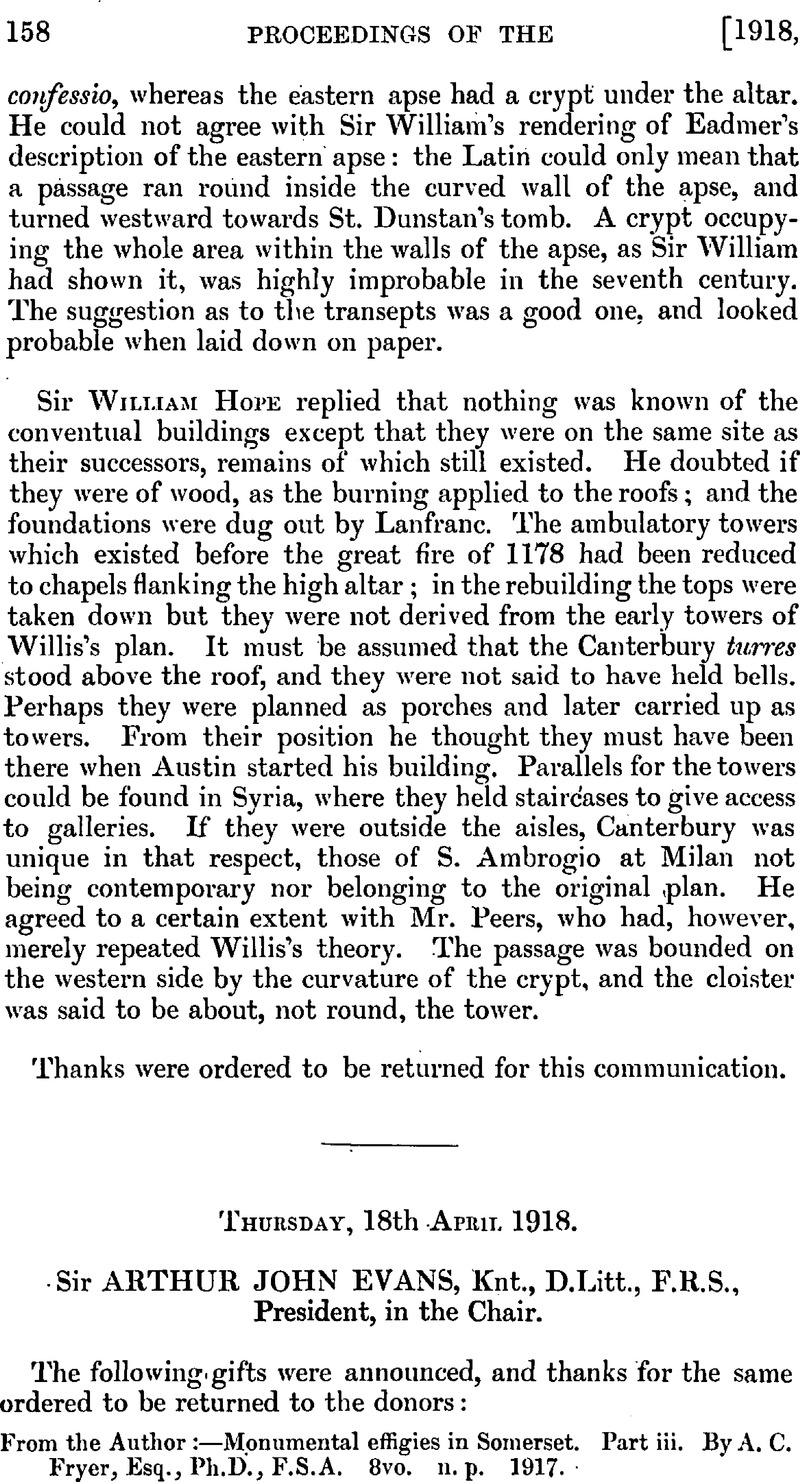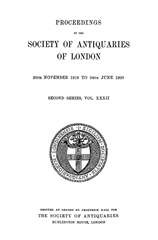No CrossRef data available.
Article contents
Thursday, 18th April 1918
Published online by Cambridge University Press: 10 May 2010
Abstract

- Type
- Proceedings
- Information
- Copyright
- Copyright © The Society of Antiquaries of London 1918
References
page 163 note 1 Archaeologia, lvii, 37. To the list may now be added a chert example found on the Quantock Hills above St. Audries, Somerset, and now in Taunton Castle museum.
page 163 note 2 Rossbach in Festschrift zum Anthropologen-Kongress Nürnberg 1913, pl. 2, fig. 19; and Obermaier in Mitteilungen der anthropologischen Gesellschaft in Wien, xliv (1914), p. 47, fig. 7Google Scholar.
page 163 note 3 R. R. Schmidt assigns a specimen to early Le Moustier (Die diluviale, Vorzeit Deutschlands, 127, fig. 43) and one more closely approaching the celt form to middle Le Moustier (his fig. 44).
page 164 note 1 Like a fine Levallois flake in the possession of Sir Ray Lankester.
page 164 note 2 Described by Mr. Reid Moir and Prof. Keith in Journ. R. Anthrop. Inst., xlii (1912), p. 345. Mr. Moir has since realized that the skeleton does not date from before the Boulder-clay, but may belong to the upper Le Moustier level found in this and adjoining pits (Nature, 12th October, 1916).
page 164 note 3 Compare one from Ickleford, Herts., in Archaeologia, lvii, 31, fig. 4.
page 165 note 1 For alleged instances of Solutré date, see Déchelette, Manuel, 174, note 2, and Matériaux, 1867, 28.
page 167 note 1 e. g. in 1075 and 1255 (see Lloyd's History of Wales, pp. 383, 715), and in the story of ‘Math the son of Mathonwy’ in the Mabinogion.
page 167 note 2 See in this connexion the British Museum Guide to the Antiquities of the Bronze Age, p. 31, where the occurrence of shields of bronze in this district and similar ones in Scandinavia is quoted as evidence of intercourse between Britain and Northern Europe.
page 167 note 3 A valuable and comprehensive survey of many archaeological problems affecting this coast is to be found in Dr. Fleure's paper, ‘Ancient Wales—Anthropological Evidences,’ in the Transactions of the Honourable Society of Cymmrodorion, 1915–16. To this paper I wish to make full acknowledgement.
page 167 note 4 e. g. Sir John Rhys pointed out that Lleyn, the name of the western part of the Carnarvonshire peninsula, corresponds to the Irish Lagin, ‘the men of Leinstet’, and that in Porth Dinllâen (a fine natural harbour protected by a fortified promontory) Dinllâen suggests Dún. Lagen, the men of Leinster's Fort. (Bedd Gelert, its Facts, Fairies, and Folk-lore, p. xiii, and Arch. Cumb., 1892, p. 73.) In this connexion the following quotation from Mr. G. Coffey's Bronze Age in .Ireland is apposite : ‘It is interesting to note that the tradition preserved in the Book of Leinster, a MS. of the twelfth century, refers the first smelting of gold in Ireland to a district in which gold has been found in considerable quantities in modern times. The Leinstermen, it is stated, were called “Lagenians of the gold ”, because it was in their country that gold was first discovered in Erin.’
page 168 note 1 Arch. Camb., 1868, p. 477.
page 168 note 2 In the volume of drawings labelled ‘Primaeval Antiquities’, also illustrated in Gough's Camden, vol. iii, pl. viii.
page 168 note 3 In certain parts of Merionethshire copper occurs in the peat and has been extracted from it in considerable quantities (Royal Institution of Cornwall, Report, 1856, p. 41).
page 169 note 1 Arch. Camb., 1859, p. 164.
page 169 note 2 Vol. iii, p. 107 (Bodleian Library, MS. Ashmole, 1829, fo. 157).
page 169 note 3 I have identified a portion of this hoard among Edward Lhuyd's collection in the Ashmolean, and hope later on to contribute a description. Two specimens are illustrated in the 1695 ed. of Camden's Britannia, pl. xx, p. 697, nos. 14, 15 ; also in Gough's edition, vol. iii, pl. viii, nos. 14, 15.
page 170 note 1 Sic for Engan.
page 170 note 2 In margin, 27.
page 170 note 3 In margin, 6500.
page 170 note 4 Bryn Engan, the home of the finder, William Cadwallader, is on the lower slopes of Moel Siabod, on the south bank of the river Llugwy, immediately opposite to and less than half a mile distant from the village of Capel Curig. In a volume in the Library of the Society of Antiquaries labelled ‘Primaeval Antiquities’ is a drawing of this shield, which is reproduced in Archaeologia, xxiii, 95.
page 170 note 5 B. M. Bronze Age Guide, p. 30 and pl. I, 2.
page 170 note 6 About 2½ miles west of Trawsfynydd and 6 miles east-north-east of Harlech.
page 171 note 1 Tours in Wales (1804–13), by Richard Fenton, pp. 118, 254.
page 171 note 2 Arch. Camb., 1850, p. 332.
page 172 note 1 The Roman station nine miles north-east of Harlech : see also p. 180.
page 172 note 2 Near Ffestiniog.
page 172 note 3 p. 155.
page 172 note 4 p. 11.
page 173 note 1 Weight 1 lb. 4 oz. + 60 grains.
page 174 note 1 Arch. Camb., 1896, p. 214.
page 174 note 2 Weight 12½ oz. + 20 grains.
page 174 note 3 About a century ago the Traeth Mawr was reclaimed by the construction of an embankment across its mouth from the spot where is now the town of Portmadoc ; the map (fig. 8) shows approximately the original shore line.
page 175 note 1 Captain Higson has since presented this rapier to the British Museum.
page 175 note 2 Charter of Llewelyn the Great to the abbey of Aberconway, 1198: Dugdale, Monasticon, v. 673.
page 176 note 1 Giraldus Cambrensis, Rolls ed., vol. iv, p. 167.
page 176 note 2 Giraldus Cambrensis, Rolls ed., vol. vi, p. 133.
page 176 note 3 Another canoe is said to have been lying in this lake (Arch. Camb., 1863, p. 335).
page 176 note 4 Cambrian Journal, 1861, p. 342. Figured, Arch. Camb., 1874, p. 147.
page 176 note 5 Proceedings, 2nd Series, vol. i, p. 10.
page 177 note 1 Proceedings, 2nd Ser. i, 161.
page 177 note 2 Dr. G. Griffith, Taltreuddyn, near Barmouth.
page 177 note 3 Copper slag has also been found in hut circles in Anglesey (Arch. Camb., 1892, p. 243).
page 177 note 4 See Arch. Camb., 1903, p. 282 for plan and description. They are known as Muriau yr Dref (Town Walls) or Tre'r Gwyddelod (Irishmen's town), and are referred to by Sir John Rhys as ‘that deserted centre of the ancient Goidel’.
page 177 note 5 The copper mine on the slopes of Snowdon above Lake Llydaw is said to contain ancient workings.
page 177 note 6 The Bronze Age in Ireland, ch. 4.
page 178 note 1 Weight 3½ oz. less 20 grains.
page 179 note 1 The field now belongs to the farm of Llystyn Gwyn.
page 179 note 2 Arch. Camb., 1903, p. 288, and 1907, p. 96.
page 180 note 1 Arch. Camb., 1905, p. 255.
page 181 note 1 Parochialia, iii, 108.
page 181 note 2 Stukeley's Itinerarium Curiosum, pl. 80, 2 d, the drawing being derived from Lhuyd's notes.
page 183 note 1 The following seals bearing lettering with which that here shown may be compared are illustrated in the Catalogue of Seals in the Department of MSS. in the British Museum : vol. iii. pl. I, no. 1,198 (1179–1211); vol. iv, pl. X, no. 15,739 (c. 1190 ?); vol. v, pl. VI, no. 18,184 (1212) ; vol. v, pl. .VI, no. 18,296 (1201) ; vol. v, pl. XIII, no. 19,373 (1199).
page 184 note 1 See Sir J. Morris Jones's Grammar, p. 166. I owe this reference to Professor J. E. Lloyd.
page 185 note 1 Arch. Journ., vol. ii, p. 46.
page 185 note 2 Vol. I, pl. III.
page 185 note 3 Arch. Camb., 1890, p. 155.
page 186 note 1 I have to thank Mr. Peers for a reference to another of these brooches which was found at Trieste and is figured in The Arts in Early England, vol. iii pl. XXVIII, no. 2. The author in his description explains in detail the functional development of the various features of fibulae of this type : see also Chiflet, Anastasis Childerici I, (1655), 182.
page 186 note 2 Archaeologia, xlviii. 100.
page 188 note 1 Catalogue of the Museum of the Royal Irish Academy.
page 188 note 2 Civilisation primitive en Italie, ii, pls. 178 ; 7 : 181 ; 15, 16.


